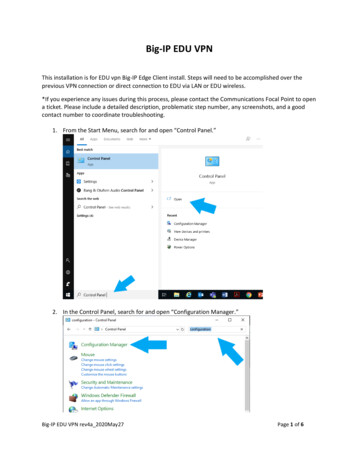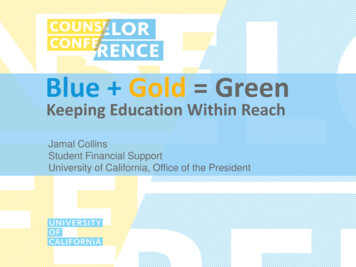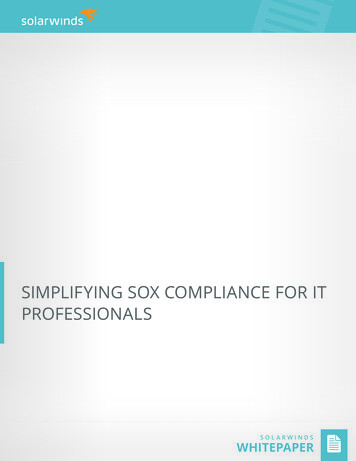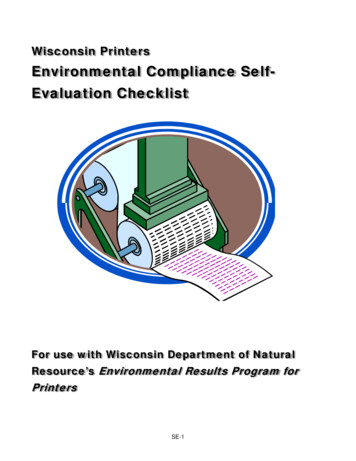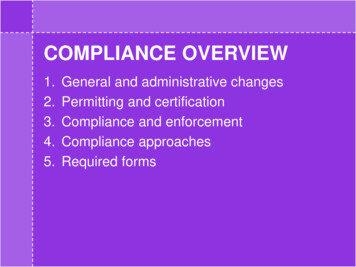
Transcription
COMPLIANCE OVERVIEW1.2.3.4.5.General and administrative changesPermitting and certificationCompliance and enforcementCompliance approachesRequired forms
LED LAMPS AND LUMINAIRES Distinctions between screw-base“replacement” lamps and others New designated rating requirementsfor LED luminaires and light engines10/7/2013SLIDE 62SECTION 4COMPLIANCE OVERVIEW
Mandatory Device RequirementsMajority of lighting control device requirements are now regulated byCalifornia Appliance Efficiency Standards, Title 20 Devices must be certified to the California Energy Commission Expanded requirements for:Automatic time switch controlsDimmersOccupant sensing devicesPhotocontrols10/7/2013SLIDE 63SECTION 4COMPLIANCE OVERVIEW
MAJOR UPDATE: TITLE 24 TRIGGERSMore alterations will be required to meet new-construction standards for bothlighting power density (LPD) and mandatory controls.Interior: Upgrades that affect more than 10% of the lighting in a space,with a minimum of 40 luminaires, must comply with the new standards.Exterior: Upgrades that replace more than 10% of the luminaires but less than50% must meet all mandatory controls requirements, but do not need tomeet the new Lighting Power Density requirements. Alterations that replace more than 50% of the luminaires in a space, orany alteration that increases the connected lighting load, must complywith all mandatory requirements and lighting power density allowances.10/7/2013SLIDE 64SECTION 4COMPLIANCE OVERVIEW
PERMITTING AND CERTIFICATIONA certificate of compliance must be signed by the person incharge of the building design in order to receive T-24 certification.Persons who prepare the Certificate of Compliance must sign adeclaration statement on the documents they prepare to certifythe information is accurate and complete.All certificates of compliance and installationmust conform to a format and information order and contentapproved by the California Energy Commission.Note that enforcement agencies will inspect both newlyconstructed buildings and alterations to existing buildings.10/7/2013SLIDE 65SECTION 4COMPLIANCE OVERVIEW
COMPLIANCE AND ENFORCEMENTPrimary responsibility for compliance and enforcement rests with the localenforcement agency, typically associated with a city or county government.A building permit must be obtained from thelocal jurisdiction before construction of: A nonresidential building An outdoor lighting system Additions to existing buildings10/7/2013SLIDE 66 Significant alterations toexisting lighting systems SignageSECTION 4COMPLIANCE OVERVIEW
ADOPTED REACH CODES (2008)State law establishes a process that allows local adoption of buildingenergy standards that are more stringent than statewide standards,sometimes called “reach codes.” Reach codes were adopted in thefollowing regions (as of March 2013):CountiesCitiesMalibuSan FranciscoMarinAnselmoManhattan BeachSan JoseSan FranciscoBelmontMenlo ParkSan Luis ObispoSanta ClaraBurlingameMorgan HillSan MateoSonomaChula VistaMountain ViewSan RafaelCotatiNapaSanta MonicaCupertinoOaklandSanta RosaDaly CityPalo AltoSebastopolFremontPacificaSimi ValleyGlendalePetalumaSonomaGoletaPortola ValleyTiburonHaywardRedwood CityUnion CityHealdsburgRichmondWest SacramentoLos AltosSan standards/ordinances/10/7/2013SLIDE 67SECTION 4COMPLIANCE OVERVIEW
EXPANDED ACCEPTANCE TEST REQUIREMENTS Lighting controls acceptance test technicians must be certified Acceptance tests expanded to include Automatic daylighting controls Shut-off controls (indoor and outdoor) Demand response controls10/7/2013SLIDE 68SECTION 4COMPLIANCE OVERVIEW
THE CORE COMPLIANCE PROCESS1. Meet all mandatory requirementsThe mandatory requirements set forth required controls that must beinstalled and the functionality that a lighting system must be capable of.The mandatory requirements will also specify if a device needs to becertified by the Energy Commission.2. Meet all prescriptive or performance requirementsThese requirements set a maximum lighting power allowance a buildingor an area within a building. A building or area complies with theserequirements if the actual lighting power used in the space is less than theallowed lighting power.10/7/2013SLIDE 69SECTION 4COMPLIANCE OVERVIEW
THE PERFORMANCE APPROACHPerformance Approach: More flexible than prescriptive Based on an energy simulation model of the building Requires an approved computer software program Uses energy budgets to determine compliance Typically used for flexibility and ability to find the most cost-effective solutionApproved software:Perform 2008 (Public Domain)EnergyPro 5.1MICROPAS 2008 computerprog list.html10/7/2013SLIDE 70SECTION 4COMPLIANCE OVERVIEW
THE PRESCRIPTIVE APPROACHPrescriptive Approach: Simpler of the two methods Each component of proposedbuilding must meet prescribedminimum efficiency Less design flexibility Failure to meet any requirementresults in non-compliance10/7/2013SLIDE 71SECTION 4COMPLIANCE OVERVIEW
THE PRESCRIPTIVE APPROACHIndoor LightingThe prescriptive lighting power requirementsare determined by one of three methods: Complete building method Area category method Tailored methodThe allowed lighting varies accordingto building occupancy and task.10/7/2013SLIDE 72SECTION 4COMPLIANCE OVERVIEW
THE PRESCRIPTIVE METHODS1.Complete building methodApplicable when the entire building’s lighting system is designedand permitted at one time, and when at least 90% of the building isone primary type of use. Some cases, the complete building methodmay be used for an entire tenant space in a multi-tenant building. ASingle allowed lighting power value governs the entire building.2.NOTE:The CompleteBuilding Methodcannot be usedfor retail spaces.Area category methodApplicable for any permit situation, including tenant improvements.Lighting power values are assigned to each major function areasof a building (offices, lobbies, etc.). The allowed lighting poweris the weighted average of these areas.3.Tailored methodApplicable when additional flexibility is needed to accommodatespecial task lighting needs in specific task areas. Lighting powerallowances are determined room-by-room and task-by-task, withthe area category method used for other areas in the building.10/7/2013SLIDE 73SECTION 4COMPLIANCE OVERVIEW
THE PRESCRIPTIVE METHODS10/7/2013SLIDE 74SECTION 4COMPLIANCE OVERVIEWCreative commons copyright: takuyaabe
THE PRESCRIPTIVE METHODS10/7/2013SLIDE 75SECTION 4COMPLIANCE OVERVIEW
REQUIRED INTERIOR FORMS1. NRCC-LTI-01-E Indoor Lighting2. NRCC-LTI-02-E Indoor Lighting Controls3. NRCC-LTI-03-E Indoor Lighting Power Allowance4. NRCC-LTI-04-E Tailored Method Worksheets5. NRCC-LTI-05-E Line Voltage Track Lighting Worksheet6. NRCI-LTI-01-E All Buildings7. NRCI-LTI-02-E Lighting Controls8. NRCI-LTI-04-E Two interlocked systems9. NRCI-LTI-05-E Power Adjustment Factor10. NRCI-LTI-06-E Video conferencing studio10/7/2013SLIDE 76SECTION 4COMPLIANCE OVERVIEW
REQUIRED EXTERIOR FORMS1. NRCC-LTO-01-E Outdoor Lighting2. NRCC-LTO-02-E Outdoor Lighting Controls3. NRCC-LTO-03-E Outdoor Lighting Power Allowances4. NRCI-LTO-01-E Outdoor Lighting Certificate of Installation5. NRCI-LTO-02-E EMCS or Lighting Control System10/7/2013SLIDE 77SECTION 4COMPLIANCE OVERVIEW
BREAK5 minute stretch
NRCI-LTI-02-E Lighting Controls 8. NRCI-LTI-04-E Two interlocked systems 9. NRCI-LTI-05-E Power Adjustment Factor 10. NRCI-LTI-06-E Video conferencing studio 10/7/2013 SLIDE 76 COMPLIANCE OVERVIEW . SECTION 4 REQ

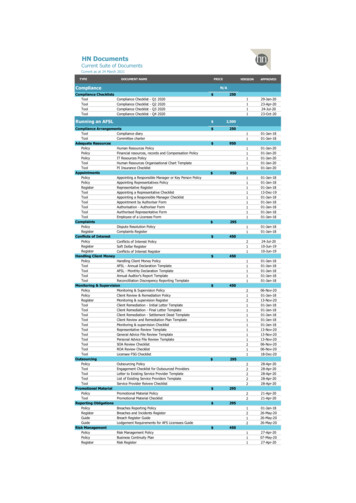
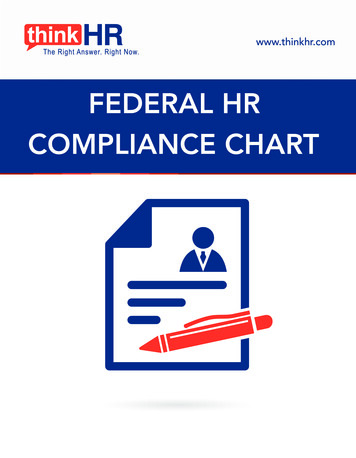

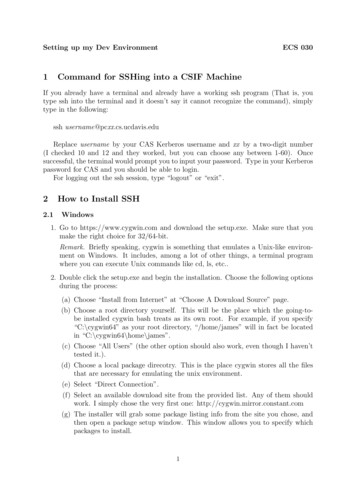
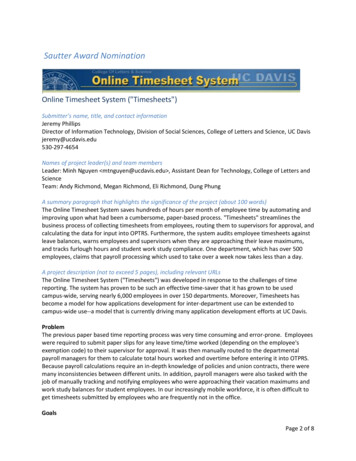
![Group 4 AggieService Client Training v1.pptx [Read-Only]](/img/9/group-204-20aggieservice-20client-20training-20v1-0.jpg)
